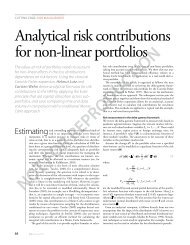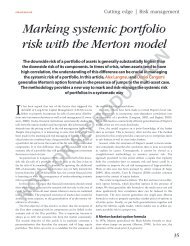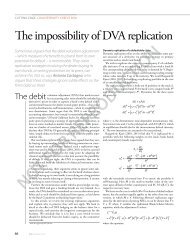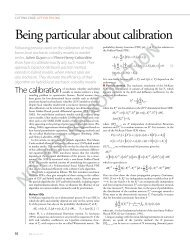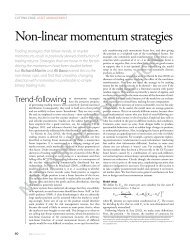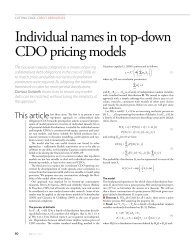The vanna-volga method for implied volatilities (PDF - Risk.net
The vanna-volga method for implied volatilities (PDF - Risk.net
The vanna-volga method for implied volatilities (PDF - Risk.net
Create successful ePaper yourself
Turn your PDF publications into a flip-book with our unique Google optimized e-Paper software.
cutting edge. option pricing<br />
Maintaining the assumption of flat but stochastic <strong>implied</strong><br />
<strong>volatilities</strong>, the presence of three basic options in the market makes<br />
it possible to build a portfolio that zeroes out partial derivatives up<br />
to the second order. In fact, denoting respectively by D and x the<br />
t i<br />
units of the underlying asset and options with strikes K held at<br />
i<br />
BS BS time t and setting C (t) = C (t; Ki ), under diffusion dynamics <strong>for</strong><br />
i<br />
both S and s = s , we have by Itô’s lemma:<br />
t t<br />
dC BS t; K<br />
40 risk South Africa Autumn 2007<br />
( ) − ∆t dSt − ∑ xidC i<br />
( )<br />
= ∂C BS ⎡ t; K<br />
⎢<br />
⎣⎢<br />
∂t<br />
( )<br />
+ ∂C BS ⎡ t; K<br />
⎢<br />
⎣⎢<br />
∂S<br />
+ 1 ⎡<br />
⎢<br />
2 ⎣⎢<br />
+ 1 ⎡<br />
⎢<br />
2 ⎣⎢<br />
( )<br />
+ ∂C BS ⎡ t; K<br />
⎢<br />
⎣⎢<br />
∂σ<br />
⎡<br />
⎢<br />
⎣⎢<br />
( )<br />
∂S 2<br />
∂ 2 C BS t; K<br />
( )<br />
∂σ 2<br />
∂ 2 C BS t; K<br />
( )<br />
+ ∂2 C BS t; K<br />
∂S∂σ<br />
3<br />
∑<br />
− x i<br />
i=1<br />
3<br />
∑<br />
3<br />
i=1<br />
− ∆ t − x i<br />
3<br />
∑<br />
i=1<br />
− x i<br />
i=1<br />
3<br />
∑<br />
− x i<br />
i=1<br />
3<br />
∑<br />
− x i<br />
i=1<br />
3<br />
∑<br />
− x i<br />
i=1<br />
( )<br />
BS<br />
∂Ci t<br />
∂t<br />
( )<br />
BS t<br />
BS<br />
∂Ci t<br />
∂S<br />
( )<br />
BS<br />
∂Ci t<br />
∂σ<br />
⎤<br />
⎥ dt<br />
⎦⎥<br />
( )<br />
⎤<br />
⎥<br />
⎦⎥<br />
( )<br />
∂ 2 BS<br />
Ci t<br />
∂S 2<br />
( )<br />
∂ 2 BS<br />
Ci t<br />
∂σ 2<br />
( )<br />
∂ 2 BS<br />
Ci t<br />
∂S∂σ<br />
⎤<br />
⎥<br />
⎦⎥<br />
dσ t<br />
⎤<br />
⎥<br />
⎦⎥<br />
⎤<br />
⎥<br />
⎦⎥<br />
dS t<br />
( ) 2<br />
dS t<br />
( ) 2<br />
dσ t<br />
⎤<br />
⎥ dSt dσ t<br />
⎦⎥<br />
Choosing D t and x i so as to zero out the coefficients of dS t , ds t ,<br />
(ds t ) 2 and dS t ds t , 5 the portfolio comprises a long position in the<br />
call with strike K, and short positions in x i calls with strike K i and<br />
short the amount D t of the underlying, and is locally risk-free at<br />
time t, in that no stochastic terms are involved in its differential 6 :<br />
dC BS t; K<br />
= r d C BS ⎡<br />
⎢ t; K<br />
⎣<br />
( ) − ∆t dSt − ∑ xidC i<br />
3<br />
i=1<br />
( ) − ∆t St − ∑ xiC i<br />
3<br />
i=1<br />
( )<br />
BS t<br />
( )<br />
BS t<br />
⎤<br />
⎥<br />
⎦<br />
dt<br />
<strong>The</strong>re<strong>for</strong>e, when volatility is stochastic and options are valued<br />
with the BS <strong>for</strong>mula, we can still have a (locally) perfect hedge,<br />
provided that we hold suitable amounts of three more options to<br />
rule out the model risk. (<strong>The</strong> hedging strategy is irrespective of<br />
the true asset and volatility dynamics, under the assumption of<br />
no jumps.)<br />
n Remark 1. <strong>The</strong> validity of the previous replication argument<br />
may be questioned because no stochastic-volatility model can<br />
produce <strong>implied</strong> <strong>volatilities</strong> that are flat and stochastic at the same<br />
time. <strong>The</strong> simultaneous presence of these features – though<br />
inconsistent from a theoretical point of view – can, however, be<br />
justified on empirical grounds. In fact, the practical advantages of<br />
the BS paradigm are so clear that many <strong>for</strong>eign-exchange option<br />
traders run their books by revaluing and hedging according to a<br />
BS flat-smile model, with the ATM volatility being continuously<br />
updated to the actual market level. 7<br />
<strong>The</strong> first step in the VV procedure is the construction of the<br />
above hedging portfolio, whose weights x i are explicitly calculated<br />
in the following section.<br />
(2)<br />
(3)<br />
Calculating the VV weights<br />
We assume hereafter that the constant BS volatility is the ATM<br />
one, thus setting s = s 2 (= s ATM ). We also assume that t = 0,<br />
dropping accordingly the argument t in the call prices. From (2),<br />
we see that the weights x 1 = x 1 (K), x 2 = x 2 (K) and x 3 = x 3 (K), <strong>for</strong><br />
which the resulting portfolio of European-style calls with<br />
maturity T and strikes K 1 , K 2 and K 3 has the same vega, ∂Vega/<br />
∂Vol and ∂Vega/∂Spot as the call with strike K, 8 can be found by<br />
solving the following system:<br />
∂<br />
( ) = ( )<br />
∂<br />
∂<br />
C<br />
K ∑ x K<br />
∂<br />
C<br />
i<br />
s s<br />
2<br />
∂ C<br />
∂s<br />
2<br />
BS<br />
BS<br />
2<br />
∂ C<br />
∂ ∂<br />
BS<br />
3<br />
i=<br />
1<br />
3<br />
( ) = ∑<br />
i=<br />
1<br />
s S0 i=<br />
1<br />
BS<br />
C<br />
K xi<br />
( K ) ∂<br />
∂s<br />
3<br />
BS<br />
( K )<br />
i<br />
( K )<br />
∂ C<br />
( K ) = ∑ xi ( K )<br />
∂ ∂S<br />
K<br />
s<br />
2<br />
2<br />
2<br />
BS<br />
0<br />
i<br />
( )<br />
Denoting by V(K) the vega of a European-style option with<br />
maturity T and strike K:<br />
BS<br />
∂C<br />
V ( K ) =<br />
∂σ K<br />
( ) = S 0 e− r f T T ϕ d1 K<br />
2<br />
( σ )T<br />
d1 ( K ) = ln S0 K + r d − r f + 1<br />
2<br />
σ T<br />
i<br />
( ( ) )<br />
where j(x) = Φ′(x) is the normal density function, and calculating<br />
the second-order derivatives:<br />
2<br />
BS<br />
( )<br />
∂ C<br />
2<br />
∂<br />
K<br />
( K ) = d1 K d2 K<br />
2<br />
∂ C<br />
( ) = −<br />
∂ ∂S<br />
K<br />
s<br />
V<br />
s<br />
BS V ( K )<br />
d2 ( K )<br />
s S s T<br />
0<br />
( ) = ( ) −<br />
d K d K s T<br />
2 1<br />
we can prove the following.<br />
0<br />
( ) ( )<br />
n Proposition 1. <strong>The</strong> system (4) admits a unique solution, which<br />
is given by:<br />
x K<br />
1<br />
x K<br />
2<br />
( ) =<br />
( ) =<br />
( ) =<br />
x K<br />
3<br />
( )<br />
( )<br />
V K<br />
V K<br />
1<br />
( )<br />
( )<br />
V K<br />
V K<br />
2<br />
( )<br />
( )<br />
V K<br />
V K<br />
3<br />
K2<br />
K<br />
K3<br />
K<br />
K2<br />
K1<br />
K3<br />
K1<br />
ln ln<br />
ln ln<br />
ln ln<br />
K<br />
K1<br />
K2<br />
K1<br />
ln ln<br />
ln ln<br />
K3<br />
K<br />
K3<br />
K2<br />
K<br />
K1<br />
K<br />
K2<br />
K3<br />
K1<br />
K3<br />
K2<br />
ln ln<br />
In particular, if K = K j then x i (K) = 1 <strong>for</strong> i = j and zero<br />
otherwise.<br />
<strong>The</strong> VV option price<br />
We can now proceed to the definition of an option price that is<br />
consistent with the market prices of the basic options.<br />
<strong>The</strong> above replication argument shows that a portfolio<br />
5 <strong>The</strong> coefficient of (dSt ) 2 will be zeroed accordingly, due to the relation linking an option’s gamma and<br />
vega in the BS world.<br />
6 We also use the BS partial differential equation.<br />
7 ‘Continuously’ typically means a daily or slightly more frequent update.<br />
8 This explains the name assigned to the smile-construction procedure, given the meaning of the terms<br />
<strong>vanna</strong> and <strong>volga</strong>.<br />
(4)<br />
(5)<br />
(6)




